28+ Sample Maternity Leaves
-
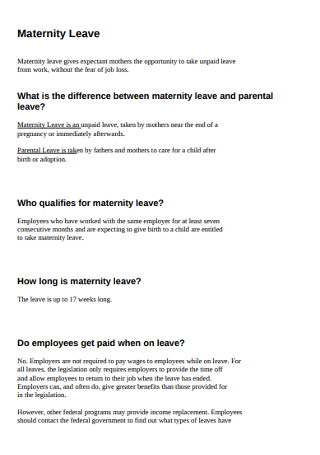
Sample Maternity Leave
-
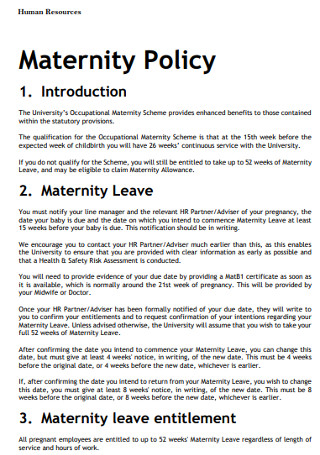
Human Resources Maternity Policy
-
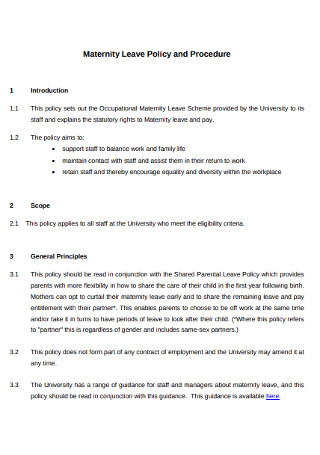
Maternity Leave Policy and Procedure
-
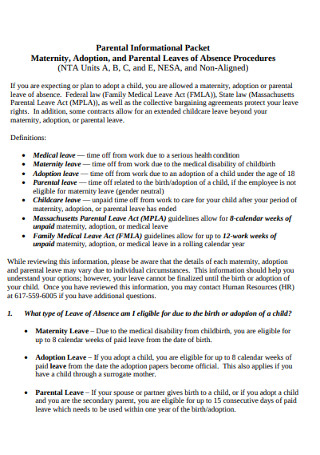
Maternity and Parental Leaves
-

Meternity Leave and Pay Support Staff Template
-
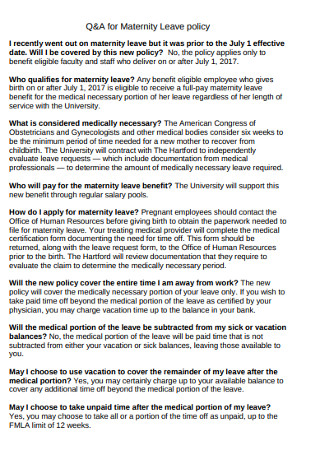
Sample Maternity Leave policy
-

Sample Pregnancy Leaves
-
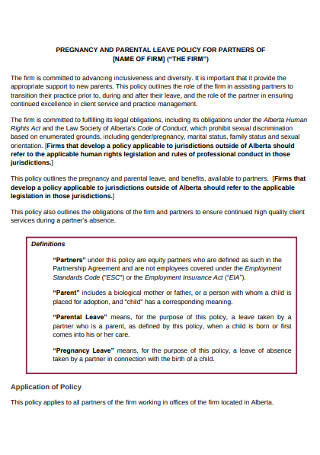
Pregnancy and parental Leaves
-
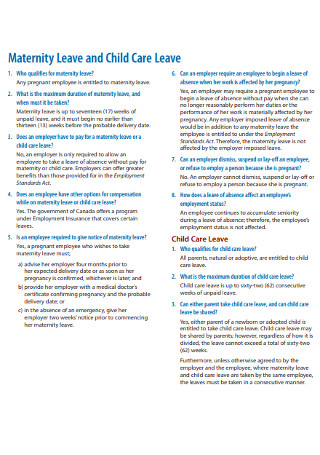
Maternity Leave and Child Care Leave
-
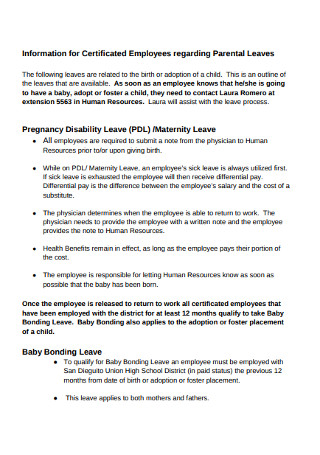
Maternity Disability Leave
-
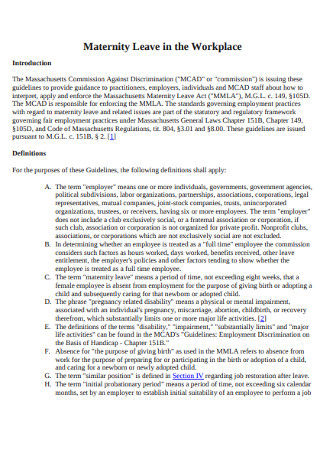
Basic Maternity Leave
-

Maternity leave and pay Template
-
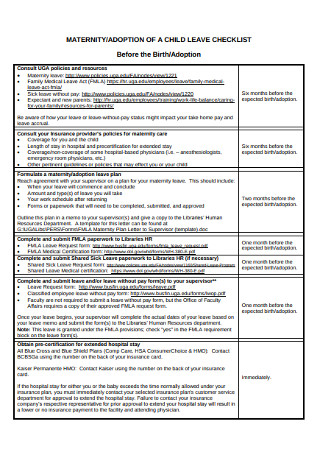
Meternity Adoption Child Leave Checklist
-
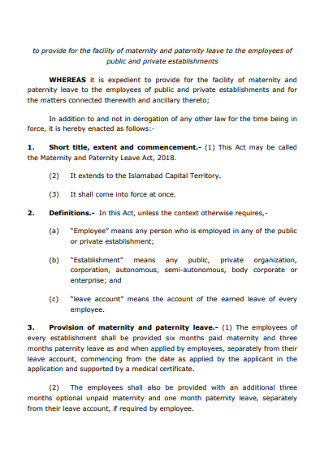
Provision of maternity and Paternity Leave
-
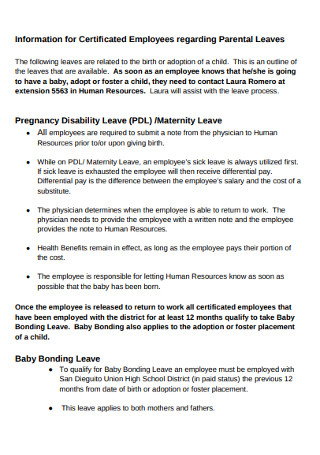
Employees regarding Parental Leaves
-
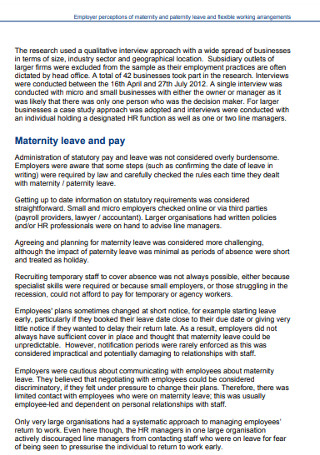
Meternity Leaves and Flexible Working Arrangements
-
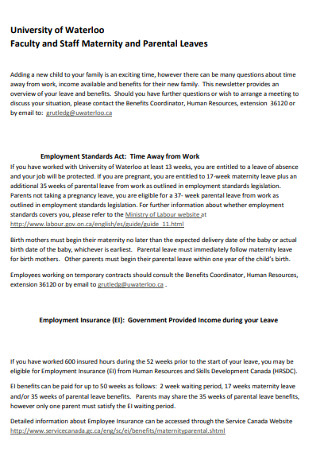
Faculty and Staff Maternity and Parental Leaves
-
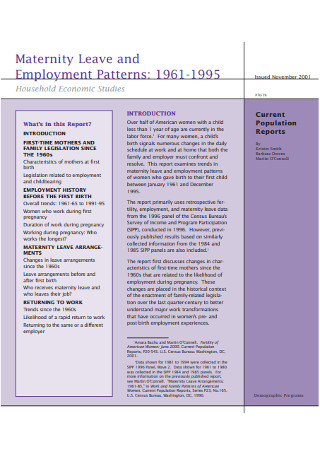
Maternity Leave and Employment
-
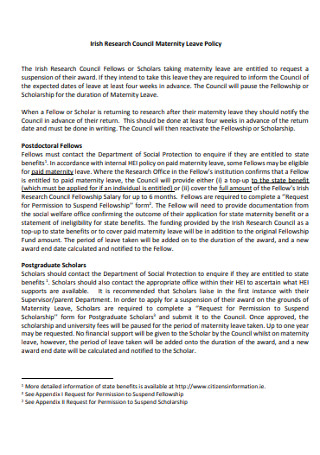
Research Council Maternity Leave Policy
-
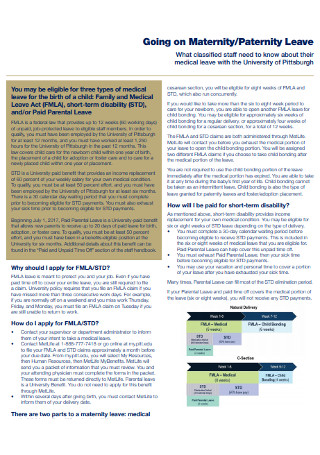
Standard Maternity Paternity Leaves
-
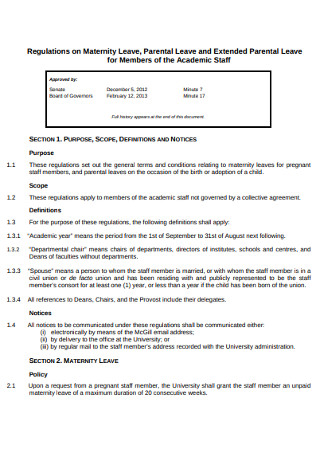
Staff Maternity Leave
-
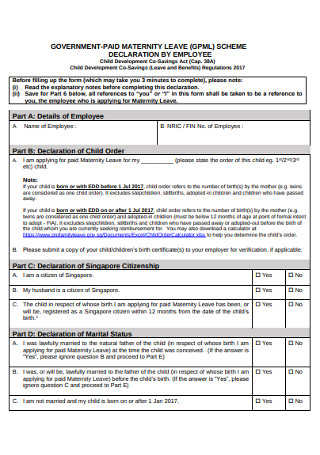
Sample Maternity Paid Leaves
-
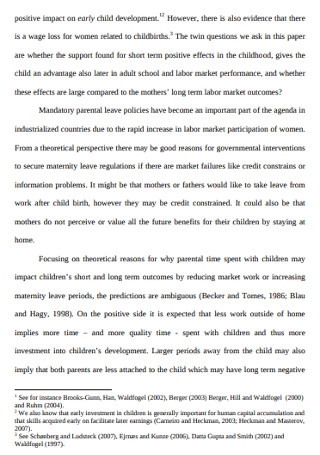
Maternity Long Term Leave
-
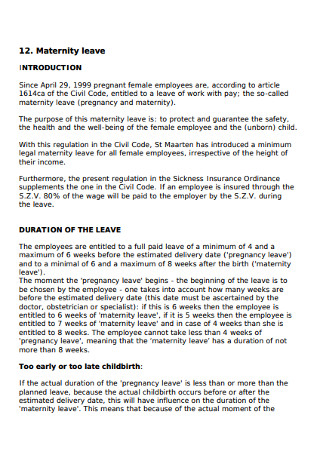
Simple Maternity leave
-
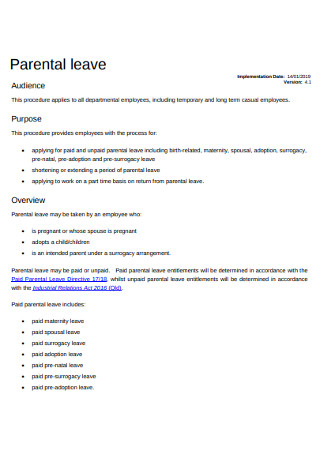
Sample Parental leave in PDF
-
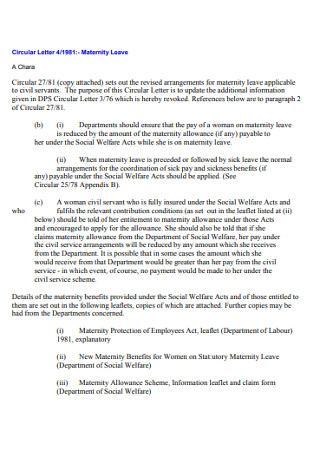
Professional Maternity Leave
-
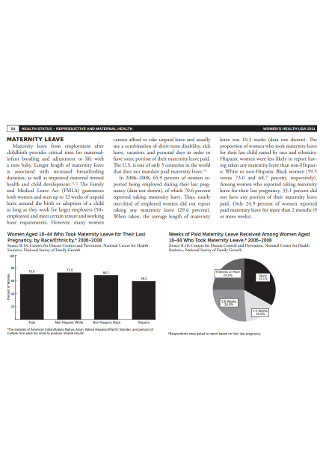
Maternity Health Leaves
-
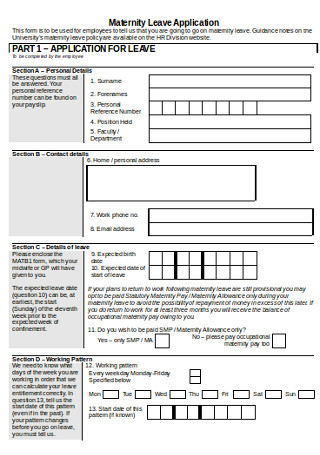
Sample Maternity Leave Application
-
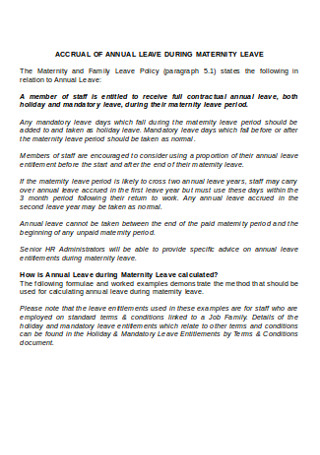
Maternity Annual Leaves
-
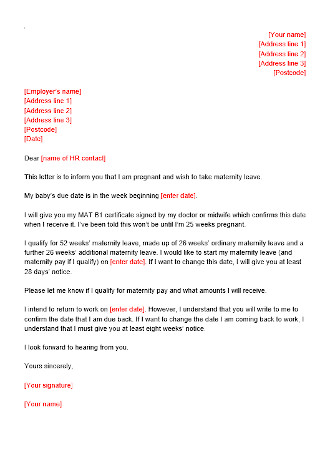
Maternity Leave Letter Template
download now -

Meternity Leave Allocation Template
download now
What Is Maternity Leave?
A maternity leave refers to the time granted to new mothers who need to take leave from work to care for themselves and their children. While fathers are also given time to look after the child through a paternity leave, mothers are offered a longer period of rest to recover from the pregnancy and to nurse the newborn baby. This includes both biological and adoptive mothers of a child. Larger companies consider this as a short-term disability that may cover a part of or the entirety of one’s salary for a particular number of weeks. Insurance providers are known to offer this type of coverage, depending on a variety of factors, as well. Employees must take the initiative to consult with their human resources department to find out the terms and conditions of the company’s parental leave so that they can gather the requirements beforehand.

The Importance of a Maternity Leave
A 2018 study by the Bureau of Labor Statistics found that 89% of employees were granted unpaid family leave, while only 17% had employers that provided them with paid family leave.
Apart from moving another step forward for feminism, there are a ton of other reasons as to why you should care about the rights of every woman to benefit from maternity leave. Newborn babies are a handful to take care of, so you can only imagine how difficult it would be for a mother to juggle the responsibilities of working a nine-to-five job while attending to the needs of a child. Keep in mind that the first few years of a child’s life are the most critical—let alone the first few weeks. Giving mothers less amount of time and energy to invest in their offspring can put the child in a lot of risks during those initial years of development.
However, maternity leaves don’t only come as a benefit to expectant mothers, but to their employers as well. New moms won’t feel obliged to leave the company they work in just to have some extra time with their newborns. This is one of the reasons why some companies began increasing their paid maternity leaves over the years for their employees. Not only does it value the rights of a working mom, but it also allows the company to invest sufficiently in employee retention. Prioritizing the well-being of women and their families should be every employer’s primary concern if they wish to maintain a happy and healthy workforce.
How to Apply for Maternity Leave
Understanding the provisions of maternity leave is just as crucial to an employee as it is to an employer. If a person wishes to come back to the same employer after giving birth, they need to take the appropriate measures to remain employed. It’s often a complicated task that not many employees are aware of until a particular time of their pregnancy. Hence, if you want to eliminate the stress and hassle that come as you approach the big day, be sure to educate yourself on the basics of applying for maternity leave. Listed below is a quick guide on how you could prepare yourself and your employer for your temporary departure.
Step 1: Understand the Terms of the Family & Medical Leave Act (FMLA)
The Family & Medical Leave Act (FMLA), or as you may recognize in a different name in your state or country, protects the personal rights of individuals by allowing them to take several days off from work to attend to a particular family or medical concern. Regular employees are considered eligible for this benefit, whether they are full-time or part-time workers. This program covers any medical complications or concerns caused by pregnancy and/or childbirth.
While you could always browse the Internet for references, it’s best to consult an attorney for expert advice on matters that are specific to state or federal laws. You may also speak with your HR manager to assess whether the company adheres to the Act as mandated by local authorities.
Step 2: Contact Your Employer about the Benefits
Upon employment, you’ll only be given an overview of what the company offers its workforce in terms of their parental leave. And now that it’s something that you need to learn more about, you must make it a point to speak with your employer regarding your pregnancy and your plans for the future. Employers would want to know whether you have any intentions to return to work following the pregnancy, or if you’d rather file a resignation to end your venture with the company as a different option. If your decision leans on the former, it’s best to take the time to read your employee handbook for information regarding your benefits. You can meet with someone from the HR department to learn more about the company’s policies regarding such, especially for instances that cover paid and unpaid leaves.
Step 3: Determine How Much Leave Time Is Allowed
The average amount of time that an employee is allowed to take under maternity leave can range from 12 to 18 weeks. This usually depends on the leave time offered by the company, and whether or not employees are permitted to use their paid vacation and sick days to add up to it. Combining the company’s leave programs along with that provided by the government is pretty standard in many workplaces. This allows new mothers to spend more time with their offspring while still having a job that they could fall back to once their child is strong enough to be cared for by an authorized caregiver.
Step 4: Write a Letter to Make the Request
Despite already informing your superiors about your pregnancy, it’s still important to make a formal letter of request to tell them about your condition as well as your plan of action for the time you are away from the office. Be sure to state your leave and return dates for the management to be informed. Contact details must also be included in the maternity leave request letter for reference in the event of an emergency or other urgent matters that require immediate attention.
Step 5: Gather the Necessary Documents
Employers are likely to request a few medical certificates to verify your condition and proceed with the necessary paperwork. When this happens, be sure to ask your health-care provider for assistance as you prepare all the required documentation before the start of your maternity leave. Although companies won’t stop you from taking time off, there’s no assurance you’ll receive the benefits employees are entitled to unless you are able to submit all the certifications that were asked. Therefore, make sure these documents are complete and informative enough to explain your condition in a way that your employer may comprehend.
The Dos and Don’ts of a Maternity Leave
Concerns of how employers view maternity leaves can put the company’s reputation at risk. The last thing you’d want is to get in trouble with the authorities over an issue involving the discrimination of pregnant women in the workforce. You don’t want to give someone any grounds to forward their claims of discrimination. Thus, it’s important to make crucial decisions carefully to ensure they conform to company standards and state laws. Listed below are some dos and don’ts that may help you make practical decisions for HR-related concerns.
Dos
1. Do ensure that the employee has all the required resources.
Some companies allow employees who are on maternity leave to continue performing their regular tasks from home. This usually happens when employees are willing to work for some time before their due date or even weeks before the time of their return, according to company policies. Regardless of one’s current circumstance, the employee must undergo proper coaching and performance feedback like every other member of the workforce. Worksheets, forms, notes, and other business documents that the employee has the authority to access must be made available for as long as she is employed to the company.
2. Do work together with the employee’s medical care provider.
Employees who are approaching a maternal leave of absence have the right to receive proper medical care from their employer. While that doesn’t mean they should be given special treatment while on the job, it does require employers to be more cautious about any medical issues that need to be accommodated at work. This goes beyond the frequent bathroom breaks and hospital checkups that pregnant women have to face, as medical practitioners highly advise their patients to avoid strenuous activities that may cause health problems for both the mother and her unborn child. Thus, it’s essential to work closely with the employee’s doctor. You can consider providing light duties, alternative assignments, or disability leaves to pregnant employees similar to how you would treat other temporarily disabled individuals.
3. Do document the employee’s leave of absence.
Always secure a written record of the employee’s leave of absence. This includes any arrangements regarding employee expectations and benefits that were agreed upon beforehand. A transition plan must also be in place to guide temporary replacements and prepare the employee for her return to work. Even if a pregnant employee informs her direct supervisor and the HR manager of her planned absence from duty, she must still submit the necessary HR documents to announce the maternity leave formally. Employees must be aware of their rights and responsibilities as a valued member of the organization through your employee handbook.
4. Do allow employees on maternity leave to carry over unused holidays.
Pregnant employees may continue to accrue their statutory and contractual holiday benefits even while on maternity leave. Keep in mind that it’s not always possible for a person to use up their current year’s holiday entitlements before they start maternity leave, especially nearing the end of the year. However, this would still depend on the policies of your company and the laws of the state. Not all employers allow their employees who are on maternity leave to carry over the holidays they were unable to take to the following year. Some employers may even encourage employees to utilize the remaining sick leaves and vacation leaves for medical check-ups and rest days before they begin their maternity leave.
5. Do establish an effective communication method.
Ask the employee the best method of communication to optimize while they’re away. While emails might seem like the most professional option, they aren’t always efficient to some. You might find it more productive to contact the employee through text or call. Also, don’t expect the employee to be quick to reply to your messages. Some pregnant women experience different medical conditions that cause them to be bedridden for weeks. If looking at the screen of their mobile phones for less than five minutes already leads to nausea, understand that the employee won’t be able to reply to urgent messages right away.
Don’ts
1. Don’t cut the employee too much slack.
In spite of the circumstance, there’s no reason to handle treat the employee lightly. Not only is it unfair to the rest of your staff, but you’re also making it easier for someone to abuse the situation to your disadvantage. The employee may sense your reluctance to provide coaching and performance advice when they need it and exhibit unfavorable behavior that is counter-productive to what you initially intended. It’s essential to make careful business decisions when it comes to providing proper care to employees and protecting the rights of the company.
2. Don’t ignore what the employee is entitled to despite being on maternity leave.
Let’s say the owner of the business just filed a company-wide pay raise. Every single person who is a regular employee in the company’s workforce is qualified for the increase in salary regardless of their position or performance in the past six months. Even if a pregnant employee is on maternity leave, she should receive the pay rise that she deserves along with the rest. This goes for employees that are being paid despite taking time off from work. Any other monetary benefits linked to one’s salary, such as incentives and allowances, must also be recalculated to ensure that compensations remain fair and correct for all.
3. Don’t feel obliged to accept any requests from the employee.
It’s not unusual for an employee to request a flexible working schedule, especially during their first trimester of pregnancy. Some may even make this request before their return from maternity leave to care for their newborn baby. Although it is not your obligation to accept any changes to the employee’s working hours, it’s essential to be reasonable with your decision to approve or deny this request. You are often given three months to make this decision before the employee reports back for work. The company’s flexible working policy must be reviewed, along with other factors that may affect your daily operations.
4. Don’t forget to keep in touch with the employee.
Before the leave starts, set a meeting with the employee to discuss matters accordingly. Some changes must be made to prepare for the employee’s temporary departure from and return to work. To keep employees who are on leave out of the dark, you’ll need to inform them regularly of any significant developments at work. This includes promotion opportunities and position vacancies that they might be interested in. You can keep them in the loop by adding the employee in your business mailing list for any company announcements, training courses, or special programs that are being communicated to the rest of your workforce.
5. Don’t assume that the employee is never coming back.
Don’t start acting as if the employee has no plans on coming back to the same job she had before her maternity leave. Expectant mothers should have the right to return to their old position unless you have a good reason to deny this. For instance, if she exceeds the standard number of maternal leaves provided by the company without prior notice, a permanent dismissal may be considered. It’s essential to look into the employee’s performance and work ethics as well. If you think it would be better if the employee didn’t come back, you can seek advice from an experienced attorney to find out how you can deal with the matter without breaking the law.
Every employee has the right to take some time off from work to attend to personal matters that directly concern them. Every employer must also make sure that an employee’s well-being is given the utmost priority under reasonable circumstances. Therefore, the arrangements for your company’s maternity leaves and other regulations under the FMLA must be crafted carefully and appropriately to address the concerns of every person in the workforce.
